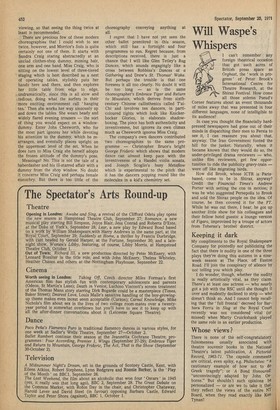BALLET
Sold a dummy
Robin Young
It was noticeable at the Ballet Rambert's premiere performance of the new piece by their director, Norman Morrice, that the audience was heavily interspersed with dancers from other companies — especially from the Rambert's close rivals in the field of dance innovation, the London Contemporary Dance Theatre. No doubt it was not seriously intended, and it might be thought unfair of me to quote it here, but the question was asked, "Do you make up each other's audiences?"; and the reply given, "Well, somebody has to."
Such ill-founded complacency is not reflected, it must be said, in the anxiously questing artistic policy of either company, nor in the conscientious standards of their performances. But after the Festival Hall crammed to capacity for the Festival Ballet's Folksy Fokines, the lab-like atmosphere of the (very uncomfortable and characterless) Jeannetta Cochrane Theatre is a different, detached and rather introverted world.
The critics, assuredly, have a hard task in explaining contemporary dance to any larger public than it presently commands. The usual thing is to say that no doubt the piece had meaning, and quite possibly all sorts of meaning, but none that would exactly admit of precise, or even imprecise, definition in words, and certainly not such as could be fully appreciated at only one viewing, so that seeing the thing twice at least is recommended.
There are precious few of these modern choreographies that I could wish to see twice, however, and Morrice's Soto is quite certainly not one of them. It starts with Sandra Craig staring abstractedly at an unclad clothes-shop dummy, missing hair, one arm and one hand. Miss Craig, who is sitting on the lowest level of three-tiered staging which is best described as a nest of operating tables, stylishly puts her hands here and there, and then explores her little table from edge to edge, -.:undramatically, since this is all slow and I tedious, doing what the surfers in their 'more exciting environment call hanging ten.' Then she works her way sinuously up and down the tables. She wears beady and widely flared evening trousers — the sort of thing you would expect on a windowdummy. Enter John Chesworth, who for the most part ignores her while devoting his attention to the dummy, which he rearranges, and eventully places upright on the uppermost level of the set. When he does turn to Miss Craig she herself adopts the frozen attitude of the dummy's pose.
Meanings? No. This is not the tale of a haberdasher and his ill-starred affair with a dummy from the shop window. No doubt it concerns Miss Craig and perhaps female eunuchry. But there is too little of the choreography conveying anything at all.
I regret that I have not yet seen the other ballet premiered in this season, which still has a fortnight and four programmes to run. Regret because, from descriptions received, there is just a chance that I will like Glen Tetley's Rag Dances, which sounds engagingly like a cross between Robbins's Dances at a Gathering and Drew's St. Thomas' Wake. But perhaps the trouble is that one foresees it all too clearly. No doubt it will be too long — as is the same choreographer's Embrace Tiger and Return to Mountain, which derives from sixthcentury Chinese callisthenics called T'aiChi and involves ten dancers, in particoloured tights which look like Knickerbocker Glories, in elaborate shadowboxing. The piece has both authenticity and inventiveness, but ignores its own climax much as Chesworth ignores Miss Craig.
The company's own dancers contributed two choreographies to the same programme — Christopher Bruce's bright George Frideric which shows that modern dance can almost keep pace with the inventiveness of a Handel violin sonata, and Joseph Scoglio's busy Metaflow which is experimental to the pitch that it has the dancers popping round like the molecules in a kid's chemistry set.



































 Previous page
Previous page